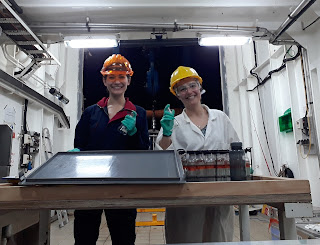I entered the field of oceanography in order to spend more time doing science whilst out at sea so I’m always looking for my next ocean adventure. Therefore, I was delighted to be asked to help with oxygen analysis on the RAPID cruise, which services the 15 moorings and landers that make up the RAPID array, measuring the Atlantic Meridional Ocean Circulation (AMOC). The main reason I love going on research cruises is that the one thing they have in common is that whilst the science is underway there’s very rarely a dull moment.
The RAPID cruise has quite a varied schedule but a typical day often unfolded as below.
Although RAPID is a mooring cruise, a couple of days started relatively early in order to release an Argo float. Argo floats are free-drifting instruments that can take vertical profiles of temperature and salinity every 10 days for up to 10 years and beam their data straight to on online database (http://www.argo.ucsd.edu/). There are currently ~3800 of these floating in the oceans which provide a high spatiotemporal resolution of the physical state of the oceans, hugely valuable information for all oceanographers.
| Argo floats aside, the day properly starts with a full English breakfast at 7:30, brilliantly prepared by the chefs, potentially with an extra pain au chocolat and/or fruit salad depending on how strenuous the day’s schedule looks. Moorings are most safely recovered and deployed during daylight hours so by 08:00 a mooring was usually either being sent out to sea. |
|
Or one was being brought back in and all the sensors cleaned and their 18 months worth of data recovered.
With the longer moorings having 5 km of cable with ~32 sensors this took anything up to 4 hours when all went smoothly. This was followed by a quick lunch, which could been anything from baguettes and chips to a three course soup, fish and cake extravagance (again many thanks to the brilliant chefs), before getting back to work.
One of the moorings recovered (EB1) had a remote access sampler (RAS) tethered at 50 m depth. The RAS collects a water sample every 11 days for 18 months which will be analysed for nutrients and dissolved inorganic carbon. We were able to collect 42/44 samples which is a brilliant recovery rate given the amount of life the RAS collected in its 18 months at sea. However, it, like all of the other sensors required cleaning so most of that afternoon was spent getting to grips with the pressure washer.
  |
Transformation from green to clean
|
When not cleaning green sea creatures the afternoon was spent checking the data from the sensors that had just been recovered and ensuring that they had been collecting data whilst they were deployed. Oxygen has been measured on some of the Eastern boundary moorings for the last 3 years so it’s pretty exciting to add on the latest 18 months hot off the press(cable?) and to start to look at the changes in oxygen over the last few years.
A 5:30 dinner initially felt obscenely early, but after a full day outside or scrubbing sensors I’m more than ready to eat another 3 course meal (I’ll never give enough thanks to the chefs) before settling down to evening activities.
On the moorings that had oxygen sensors a calibration with oxygen values measured from water samples was completed before the mooring was recovered and after the mooring was deployed. This helps to line up the sensors with an accurate oxygen reading before they’re left to their own devices for 18 months. As the moorings took up the daylight hours, collection of the water samples usually occurred at night.
 | |
|
If no sampling was needed evening activities ranged from competitive table football games, and watching awful boxsets to a quick run followed by a longer sauna. Finally, if it was a cloudless night a wander up to the top of the bridge made for some incredible stargazing before heading to bed and doing it all again the next day. Wouldn’t change a thing.


Comments
Post a Comment